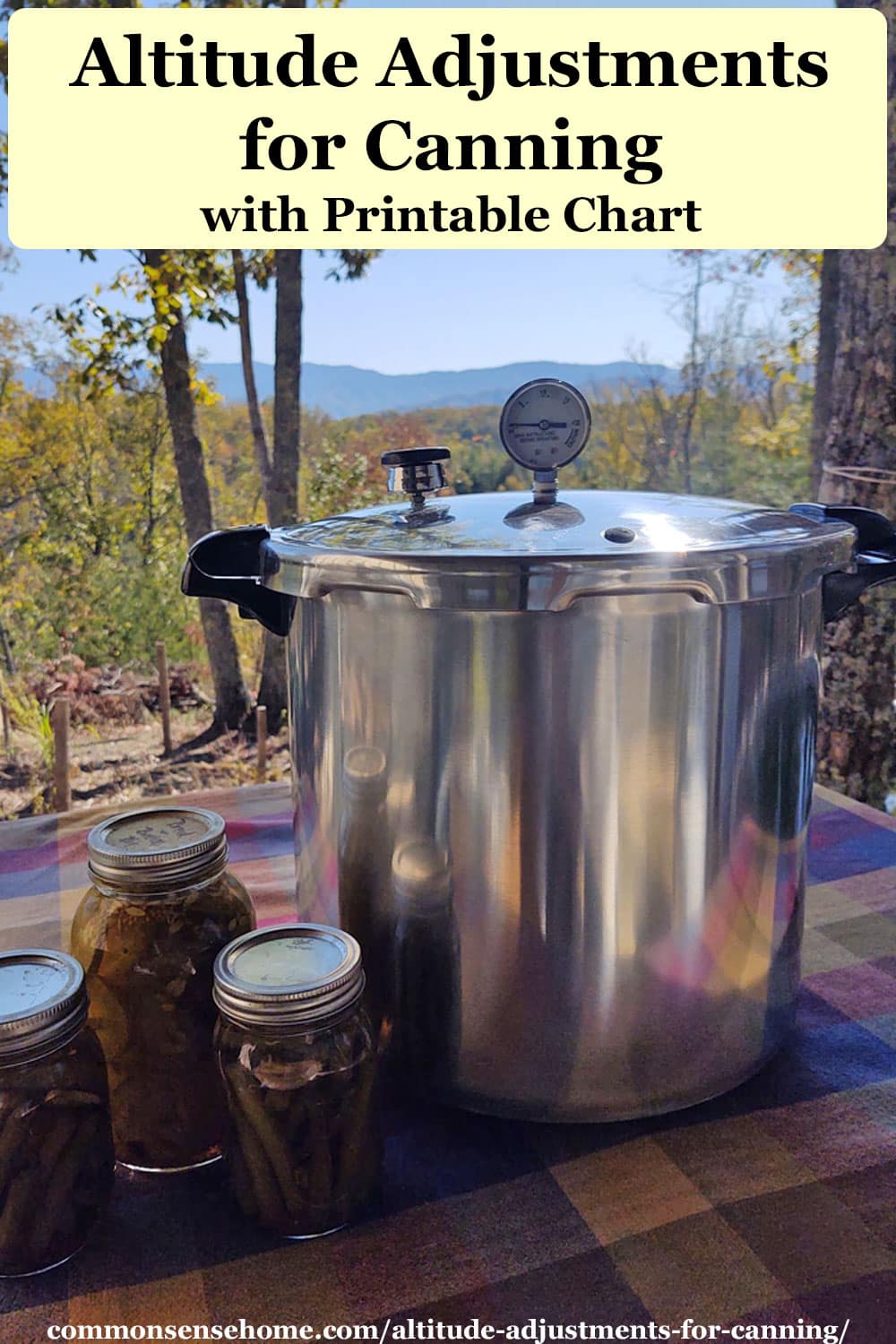Altitude Adjustments for Canning (Includes Printable Chart)
This post may contain affiliate links. Read my full disclosure here.
Altitude adjustments for canning depend on both elevation and type of canning. You need to either increase pressure or increase processing time.
If you live at an altitude of over 1,000 feet above sea level (305 meters), then you need to adjust processing times or pounds of pressure for safe home canning.
The instructions for canning altitude adjustments on the National Center for Home Food Preservation website are about as clear as mud. These charts are from the Ball Blue Book folks and South Dakota State University, so I figure they know what they’re doing.
Table of contents
Why do we need altitude adjustments for canning?
We need altitude adjustments for canning because of atmospheric pressure. Higher altitudes have less of it because there’s less atmosphere pressing down on them.
Once you go above 1000 feet, water boils at temperatures lower than 212 degrees Fahrenheit.
To compensate for this, we add either extra time or extra pressure to kill off the botulism spores and other microbes.
Pressure Canning Altitude Chart
If you are canning at an altitude higher than 1,000 feet above sea level, adjust pressure canner pounds as indicated below.
For pressure canning, you don’t need to increase the processing time, only the amount of pressure used. The numbers shown in the chart are the pressure you should use at each elevation.
Altitude Feet Weighted Gauge Dial Gauge
- 0 – 1,000 10 11
- 1,001 – 2,000 15 11
- 2,001 – 4,000 15 12
- 4,001 – 6,000 15 13
- 6,001 – 8,000 15 14
- 8,001 – 10,000 15 15
For example, if the instructions said to process at 11 pounds of pressure in a dial gauge canner at sea level, I should increase the pressure to 13 pounds of pressure if I live at 5000 feet.
Hot Water Bath Canning at High Altitude
High acid foods like fruits, jams, jellies, and pickles use hot water bath canning.
Would you like to save this?
The altitude adjustment for canning in a water bath canner simply involves extra processing time. Use the chart below.
Altitude Feet Increase Processing Time
- 1,001- 3,000 5 minutes
- 3,001- 6,000 10 minutes
- 6,001- 8,000 15 minutes
- 8,001-10,000 20 minutes
For example, if you live at 7000 feet, and the processing time for a canning recipe is 10 minutes, you should process the recipe for 25 minutes (10 + 15).
Grab a printable pdf of the altitude adjustment charts for canning here.
How to Find Your Altitude
Start by searching “elevation of (your town, your state)” in your favorite online search engine.
For example, searching on “elevation of Green Bay, Wisconsin” gives me an answer of 581′ above sea level.
If you can’t find your town, pick a larger nearby metropolitan area.
Alternatively, you should also be able to find your altitude from local information sources, such as your local planning commission or zoning office.
There are also online tools such as the National Map from USGS and What’s my Elevation.
More Food Preservation Tips
We have dozens of articles on home food preservation and many different preserving recipes, all listed on the Recipes and Kitchen Tips index page.
They include:
- Home Food Preservation – 10 Ways to Preserve Food at Home
- How to Can Food at Home – Quick Guide to Safe Home Canning
- Home Freeze Drying – The Good, The Bad and The Ugly

This article is written by Laurie Neverman. Laurie grew up in the kitchen, learning baking and home cooking from her momma. At age 15, she and her mom and two sisters created Irene’s Custom Cakes & Catering, which was her summer job through most of high school and college.
Originally posted in 2020, last updated in 2023.



Would you happen to know where I might find out how long and at what pressure poundage is needed to pressure can apple juice. I don’t care for the hot water bathing unless it’s a must. Thank you
Because apple juice is acidic, I’ve only seen water bath canner instructions. Processing in a steam canner would also be acceptable.
hi I’m new to canning. I’m below 1000′ & I’m follow somebody that is just over 1000′ so do I need to lower my processing time or just my pressure?
Odds are that whoever you follow will give the default 0-1000 feet altitude directions, unless otherwise noted, so you don’t need to adjust anything. If they say they are giving the directions for a higher elevation, then use the chart to adjust accordingly. A dial gauge canner would not change pressure or time. For a weighted gauge canner, you would adjust the pressure only.
I live at a 1140′ elevation. My ball canning book says to pressure can chilli at 10 lbs. Your instructions say to adjust/add both??? Do I add the 15 lbs in your chart to the 10 lbs in the recipe, making 25 lbs pressure??? The gauge only goes to 20. And, do I add more time to the 1 hour and 30 minutes to the pressure canning time?
For pressure canning, you don’t need to increase the processing time, only the amount of pressure.
I assume you have a weighted gauge canner, since you mention the recipe saying to process at 10 lbs.
For your altitude of 1140′, you would increase the pressure to 15 lbs. You do not add the 15 lbs to the 10 lbs. If you had a dial gauge canner, you would still use 11 pounds.
Thank you for clarifying the wording.
Question?
Water bathing for my altitude is 20 mins
Is this in addition to the recipe time of 15 mins? Making my total time 35 mins
Or is it just 20 mins?
The wording is strange to me
Thanks so much
Twomdranch
The chart indicates the increase in time in addition to the recipe time.
So, if your recipe processing time says 15 minutes, the National Center for Home Food Preservation advises processing for a total of 15 + 20 minutes, for 35 minutes total.
I live close to 9000′ above sea level. For my elevation, which method do you think is more foolproof? Water bath or pressure canning? Also, I have to use the burner on my propane grill outside as we cook w/ a wood burning stove inside and its way too hot this time of year to even try to can food. Would love your input as to what you think would best to start with considering my variables! 🙂
Water bath canning and pressure canning are used for different foods. They cannot be substituted for one another. For foods that are acidic, use water bath canning. For foods that are not acidic, use pressure canning. There’s more detailed information in this article – https://commonsensehome.com/how-to-can-food-at-home/
Water bath canning is typically a little easier for more people to tackle, because you simply need to get the water boiling and keep it boiling during processing. With pressure canning, you need to slowly bring the canner up to pressure, and then maintain it in a specific pressure range. This can be a little tricky if you don’t have fine control of your heat source.
If I’m at 800 ft elevation doing canning then move all these jars to 8,000 ft, which do I can to? The 800 ft or 8,000 ft?
Use the altitude where the processing is done. If you are processing at 800 ft, that’s the altitude you use.
The altitude adjustments compensate for change in boiling point of water during processing. Where the final product is stored does not change the processing time or pressure.
So if I have a digital pressure canner that doesn’t let me change the pressure, do I use the times associated with a water bath to extend the processing times?
You’d need to check with the manufacturer on that one.
By default, I’d say that’s not going to provide the same level of safety, because you need to increase the pressure, not just the time, to compensate for the altitude.
I live at 980 ft. -1000 ft. Should I adjust a little since I am so close to 1000 ft? Meaning if I use a dial gauge at 12 psi is that better than 11psi for under 1001? I have no problem being “better safe than sorry” and use 15 dial or weighted, but I don’t want it all over cooked.
If you have a dial gauge canner, you stay at 11 pounds of pressure up to 2000 feet, so you would process at 11 pounds of pressure.
If you have a weighted gauge canner, water is going to boil at a slightly lower temp at your altitude, but the 10 pound weight should be okay because you’re under 1000 feet. If you want to be extra safe, go ahead and jump up to the 15 pound.
Thank you.
I live in Chicago my elevation is 594 what should my canner dial or weighted be, I get confused with it and always use the 15 on weighted
You are under 1000 feet, so you can use the default instructions with canning recipes. That’s 10 pounds for a weighted gauge canner.